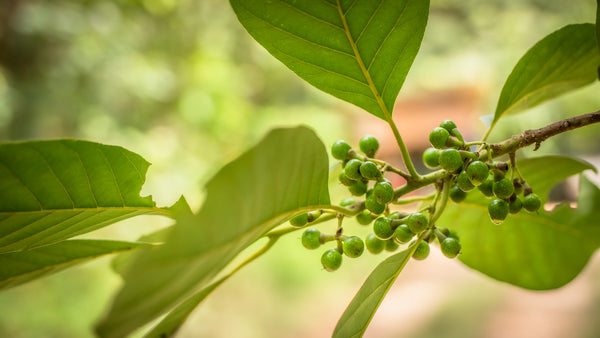
Litsea Essential Oil-Benefits, Uses, and Origin
Litsea’s pepper-like fruits are the source of litsea essential oil that have been used for thousands of years for its many healing properties.


Photo by Nipho Pittaya from iStock
Litsea (Litsea cubeba) is an evergreen tree native to China and other Southeast Asian countries including Indonesia and Taiwan. It is commonly known as may chang and mountain pepper. Though it does not belong to the citrus family, the oil gives off an aroma similar to that of a lemon.
Litsea can grow up to 35 feet in height. It has white or pale-yellow flowers. Litsea essential oil is derived from the plant’s pepper-like fruits. Although essential oil can also be harvested from its leaves, oil from the fruit is more potent and is of higher quality. Its wood is used for making furniture and different types of craft. It has also been used for a number of dishes.
Aside from being valued for its oil, litsea plant is also used to feed muga silkworms. It is said that the muga silk produced by these worms after being fed by litsea is creamier and of higher and more expensive value.
Litsea essential oil is derived through steam distillation of its fruits. Its pale yellow color emits a refreshing citrus aroma that is similar to that of citrus fruits or lemongrass. China is known to be the largest producer and exporter of Litsea essential oil in the world. The key components of the oil are geranial, neral, d-limonene, β-thujene, β-pinene, α-pinene, and linalool. These components differ depending on the part of the plant where the essential oil is derived and from the place it was harvested.
Traditional Uses of Litsea Essential Oil
Traditional Chinese medicines used litsea plant parts such as the roots, fruits, leaves, and barks to treat a number of diseases. It has been used to treat muscle pains and stomach pains, colds, fevers, diarrhoea, and indigestion. Indigenous groups in Taiwan have been using litsea for its cleansing properties.
Chinese physicians have used litsea oil to control blood pressure and regulate heart rate.
In the 1950s, litsea was introduced in Western countries where it was used for perfume and soap production and as flavoring.
Litsea essential oil was used to mitigate negative energy and improve spiritual health in Ayurvedic medicine.

Benefits of Using Litsea Essential Oil
Eases digestion
Litsea essential oil’s carminative properties helps relieve common digestion problems such as flatulence, cramping, and indigestion to name a few. It also balances the population of good bacteria in the digestive tract making it healthy. It can also enhance appetite.
Adding a few drops of litsea essential oil to a massage oil or mixing it with bathwater can alleviate gas pain when massaged in the abdomen.
For respiratory problems
Litsea essential oil is known to treat conditions such as cough, cold, bronchitis, asthma, and allergies. It is best used in a diffuser or mixed with carrier oil and massaged into the neck and chest.
Combats cancer cells
Litsea oil in vapor form fights cancer cells of the non-small cell lung carcinoma, a common form of lung cancer. Aside from to destroy the cancer cells, it also inhibits their regeneration.
Reduce body pains
Litsea essential oil is usually added to massage oils. Its anti-inflammatory property helps reduce muscle and joint pain. It is also known to ease backpains, muscular tensions, arthritis, and rheumatism.
Good for the heart
The regular use of litsea essential oil helps manage blood pressure. It is also good for people suffering from arrythmia by reducing its occurrence. Blending litsea with neroli and rose essential oil helps reduce blood pressure.
Relieves stress
Litsea essential oil has the ability to create a relaxed and cheerful atmosphere which helps boost the mood. Its citrus floral scent also helps reduce fatigue and symptoms of stress and anxiety. Aromatherapists refer to it as the ‘Oil of Tranquility’ for its calming effect.
For healthy skin
Litsea oil helps remove excess sebum which usually causes the occurrence of acne. It is a known skin cleanser because of its anti-bacterial properties. It helps balance the oil production and minimize pores and treat conditions such as acne eczema and psoriasis. It can be added to moisturizers and lotions.
Its antifungal property also works against athlete’s foot, ringworm, and other fungal infections. It can also be used as an alternative for commercial deodorant because of its ability to control excessive sweating.
One of litsea essential oil’s key component which is citral is proven to be effective for treating internal and external infections. It was also it was also found to inhibit the growth of certain bacteria strains such as the E coli. For topical application of litsea essential oil, it is recommended to blend it with either eucalyptus oil or orange oil to maximize its effect.
Powerful antioxidants in the oil helps in the repair of skin cells protecting it from free radicals and prevent premature ageing.
Repels insects and gets rid of unwanted odor
When used in a diffuser, litsea essential oil helps repel insects at home such as flies and mosquitoes. It also gives the house a clean and fresh feeling.
Safety Tips and Precautions
Although litsea is an effective healing plant used in many cleansing and beauty products, not everyone can use it.
For pregnant women babies, and infants, it is not advised to use litsea essential oil.
A skin patch test should be done first before using litsea oil with massage oils. This is to see if there would be any allergic reaction that would occur. Also, it is not advised to use the oil on damaged skin.
It is not recommended to use litsea essential oil for people suffering from glaucoma since it can increase pressure in the eyes.
